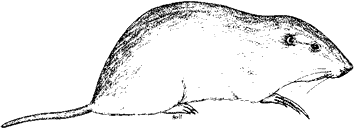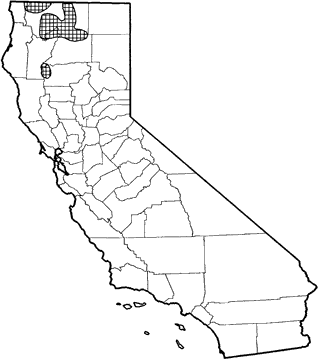
Western Pocket Gopher
Distribution, Abundance, and Seasonality
Common, yearlong resident in meadow and grassland habitats in the Klamath and western Cascade Ranges. Western pocket gophers usually do not inhabit forests; prefer open, grassy areas (Maser et al. 1981).

Range Map
Specific Habitat Requirements
Feeding: Western pocket gophers are herbivorous. They eat above- and below-ground portions of a wide variety of plants such as lupines, clovers, false dandelion, and various grasses (Maser et al. 1981). These gophers forage from tunnels and, particularly at night, on the ground surface. They chew roots and may gnaw bark of young trees in winter (Bailey 1936). Food may be transported in external fur-lined cheek pouches to underground caches.
Cover: Burrows dug in friable soil provide the predominate source of cover for pocket gophers.
Reproduction: Young are born in nesting chambers excavated in deeper sections of the burrow system. Friable soils at least 15-34 cm (6-12 in) deep are required by T. mazama (Bailey 1936).
Water: Water needs probably met from food and from moisture in the burrows.
Pattern: Open, herbaceous habitats with friable soils are required by western pocket gophers.
Species Life History
Activity Patterns: Active yearlong. Above ground, activity primarily is limited to evening and the night, but they may be active any time on warm, cloudy days. Underground activity also occurs at any time (Maser et al. 1981).
Seasonal Movements / Migration: Non-migratory.
Home Range: No data found.
Territory: Probably territorial, with territory and home range consisting of the burrow system. Pocket gophers are solitary, except during the breeding season.
Reproduction: Females produce 1, or more, litters per yr, most commonly between March and June. Scheffer (1938) found the gestation period to be approximately 28 days (N = 312), and the average litter size was 5. Following weaning, young pocket gophers leave the burrow. Maximum age of western pocket gophers probably is about 3 yr (Ingles 1965).
Niche: Pocket gophers (Geomyidae) occur only in North America. Ingles (1965) discussed the many special adaptations of pocket gophers to fossorial life. May damage crops and young trees. However, their burrowing facilitates soil formation. Also benefit the invertebrates, amphibians, and other mammals that live in their burrows. Badgers, coyotes, skunks, domestic dogs and cats, owls, hawks, weasels, and snakes prey upon T. mazama (Scheffer 1932, Forsman 1976).
Sources & References
California Department of Fish and Game, 1999.
California's Wildlife, Sacramento, CA.
Written by: G. Ahlborn, reviewed by: M. White, edited by: M. White
Bailey, V. 1936. The mammals and life zones of Oregon. U.S. Dep. Agric., North Am. Fauna No. 55. 416pp. Burt, W. H., and R. P. Grossenheider. 1976. A field guide to the mammals. 3d ed. Houghton Mifflin Co, Boston, MA. 289pp. Forsman, E. D. 1976. A preliminary investigation of the spotted owl in Oregon. M.S. Thesis, Oregon State Univ., Corvallis. 125pp. Ingles, L. G. 1965. Mammals of the Pacific states. Stanford Univ. Press, Stanford, CA. 506pp. Maser, C., B. R. Mate, J. F. Franklin, and C. T. Dyrness. 1981. Natural history of Oregon coast mammals. Pac. Northwest For. And Range Exp. Sta., USDA, For. Serv., Gen. Tech. Rep., PNW-133. 496pp. Scheffer, T. H. 1932. Weasels and snakes in gopher burrows. Murrelet 13:54-55. Scheffer, T. H. 1938. Breeding records of Pacific Coast pocket gophers. J. Mammal. 19:220-224.
California Animal Facts | California's Wildlife